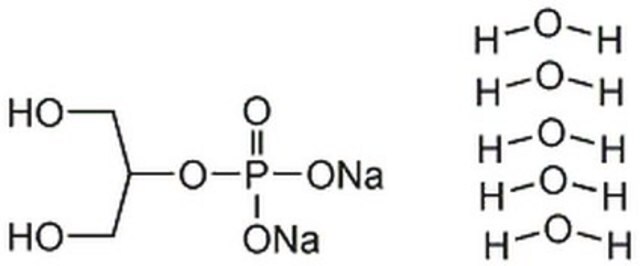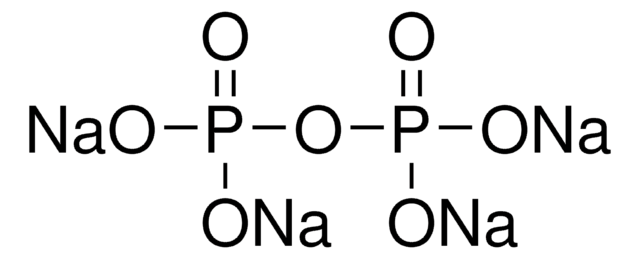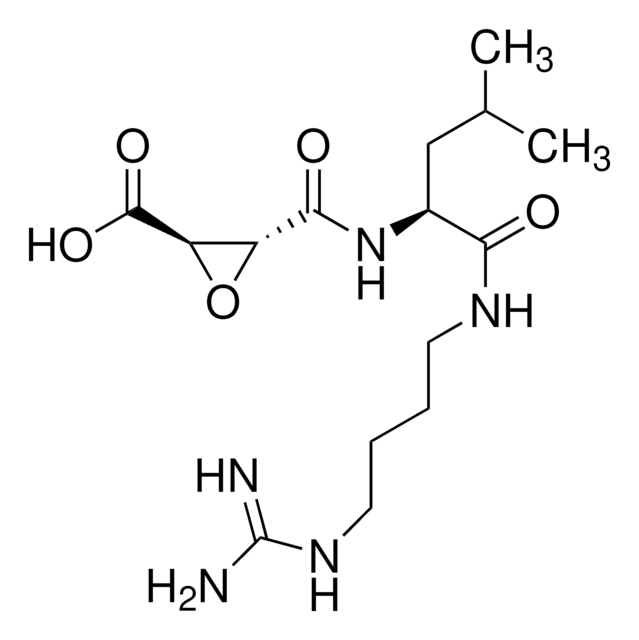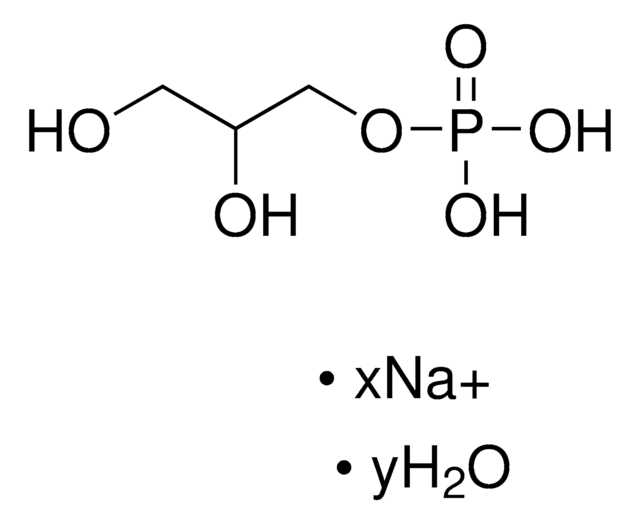G9422
β-Glycerophosphate disodium salt hydrate
BioUltra, suitable for cell culture, suitable for plant cell culture, ≥99% (titration)
Sinónimos:
BGP, Glycerol 2-phosphate disodium salt hydrate
About This Item
Productos recomendados
origen biológico
synthetic (chemical)
Nivel de calidad
Línea del producto
BioUltra
Ensayo
≥99% (titration)
Formulario
powder
técnicas
cell culture | mammalian: suitable
cell culture | plant: suitable
impurezas
≤0.1% Insoluble matter
≤0.5 mol % L-α-isomer
color
white
mp
102-104 °C (lit.)
solubilidad
water: soluble
trazas de anión
chloride (Cl-): ≤0.05%
sulfate (SO42-): ≤0.05%
trazas de catión
Al: ≤0.001%
Ca: ≤0.001%
Cu: ≤0.0005%
Fe: ≤0.001%
K: ≤0.005%
Mg: ≤0.0005%
Pb: ≤0.001%
Zn: ≤0.0005%
cadena SMILES
O.[Na+].[Na+].OCC(CO)OP([O-])([O-])=O
InChI
1S/C3H9O6P.2Na.H2O/c4-1-3(2-5)9-10(6,7)8;;;/h3-5H,1-2H2,(H2,6,7,8);;;1H2/q;2*+1;/p-2
Clave InChI
ROPZSVKNEIIIDE-UHFFFAOYSA-L
¿Está buscando productos similares? Visita Guía de comparación de productos
Descripción general
In cell biology, β-Glycerophosphate disodium salt plays a pivotal role as a phosphate group donor in matrix mineralization studies and accelerates calcification in vascular smooth muscle cells. It also promotes bone matrix mineralization when delivered to osteoblasts, providing a crucial source of phosphate ions. In the realm of biochemical research, BGP functions as a classical serine-threonine phosphatase inhibitor in kinase reaction buffers, offering broad-spectrum inhibition. Its role as an organic phosphate donor is particularly valuable in culture media for mesenchymal stem cell differentiation to osteoblast-type cells. Moreover, BGP is utilized to buffer M17 media for Lactococcus culture in recombinant protein expression. The comprehensive utility of BGP spans multiple areas of research, making it an essential component in studies encompassing cell biology, biochemical research, and metabolomics.
Aplicación
Características y beneficios
- Versatile and adaptable for a wide variety of laboratory and research applications
- Suitable for Cell culture and Plant cell culture
- Tested to confirm low levels of heavy metal contamination, ensuring suitability for various applications
- BioUltra Grade for your Cell Biology and Biochemical research
Calidad
Otras notas
producto comparable
Palabra de señalización
Warning
Frases de peligro
Consejos de prudencia
Clasificaciones de peligro
Eye Irrit. 2
Código de clase de almacenamiento
11 - Combustible Solids
Clase de riesgo para el agua (WGK)
WGK 3
Punto de inflamabilidad (°F)
Not applicable
Punto de inflamabilidad (°C)
Not applicable
Elija entre una de las versiones más recientes:
¿Ya tiene este producto?
Encuentre la documentación para los productos que ha comprado recientemente en la Biblioteca de documentos.
Los clientes también vieron
Nuestro equipo de científicos tiene experiencia en todas las áreas de investigación: Ciencias de la vida, Ciencia de los materiales, Síntesis química, Cromatografía, Analítica y muchas otras.
Póngase en contacto con el Servicio técnico










